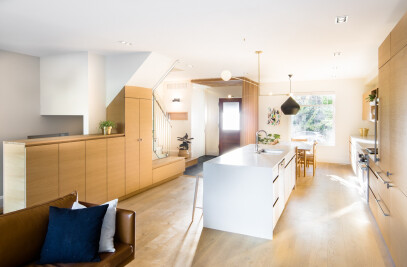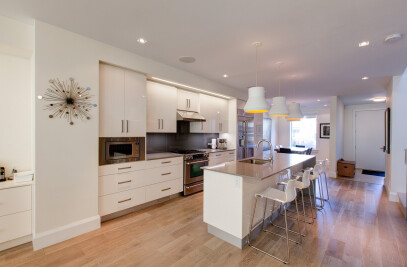Set on a rock formation overlooking a spectacular lake, the Cliff House seeks to enhance the extraordinary surroundings through the thoughtful integration of building elements with the natural assets of the site and terrain. The program called for intimate spaces carefully tuned to the unique views, light, and breezes of the site. Self-sufficiency was a key client mandate and the project is completely off-grid.
The dwelling emerges form the cliff and rests on a base crafted from local granite. A tall central void acts as an anchor that circulates movement, light and air into living spaces that pinwheel and extend into the landscape. Balancing the heavy mass of two interior fireplace cores; cantilevered volumes, flying roofs and floor-to-ceiling glass achieve a lightness of form and work to draw the lake into each interior space. Finely crafted materials, including hand-hewn stonework, wood ceilings, and structural board-formed concrete walls, define the residence and celebrate the skilled contributions of all tradespeople involved.
Living lightly on the site was important to the owners and the architects were given a strong mandate for sustainability. As a retreat for the family, the desire to become completely self-sufficient and independent from external infrastructure became critical to the design of this off-grid residence. The design achieves this aim by combining passive and active systems. Sustainable design in this case is not divorced from the experiential qualities of the dwelling but enhances the unification of building and landscape.
This design implements a passive gain and solar mass strategy that takes advantage of the sun’s daily passage and the movement of air in different seasons. In summer, solar shading limits heat gain while operable windows are orientated to take advantage of natural ventilation. Operable windows in the vertical circulation space are create a stack effect to vent hot, stale air above and draw cool, fresh air in below. Green roofs mediate temperatures and control runoff while connecting the building foreground with the distant landscape. Optimized glazing and solar orientation in conjunction with the thermal mass of concrete slabs and stone walls forms the basis of the heating system. A high performance envelope and super-insulated glass work to limit unfavorable heat loss and gains all year-round. These passive strategies reduce energy loads and augment comfort so that the demands on active systems are minimized.
Two contra-flow masonry heaters (ultra clean burning) in the fireplace cores take full advantage of abundant biomass available on site for supplemental heat. An array of evacuated tube solar collectors use the sun’s energy to heat water that circulates through 10 thermal storage tanks. This massive store of energy supplies hydronic radiant floor heating and provides domestic hot water. A series of photovoltaic panels and battery bank provide the building with electricity. Electrical loads have been carefully managed and are minimized through the use of energy efficient appliances and LED and compact fluorescent lighting.
Designed for an off-grid property, this cottage will feature a hybrid wood/solar radiant heating system with propane backup. Evacuated tube solar arrays will fill mass store tanks that feed a hydronic radiant floor system. This system will supplement a passive gain and solar mass strategy. Summer cooling is through solar shading and passive stack effect ventilation. A series of photovoltaic panels provides the buildings on the property with electricity. Large overhangs control the solar gain while green roofs mediate temperatures and control runoff.

































